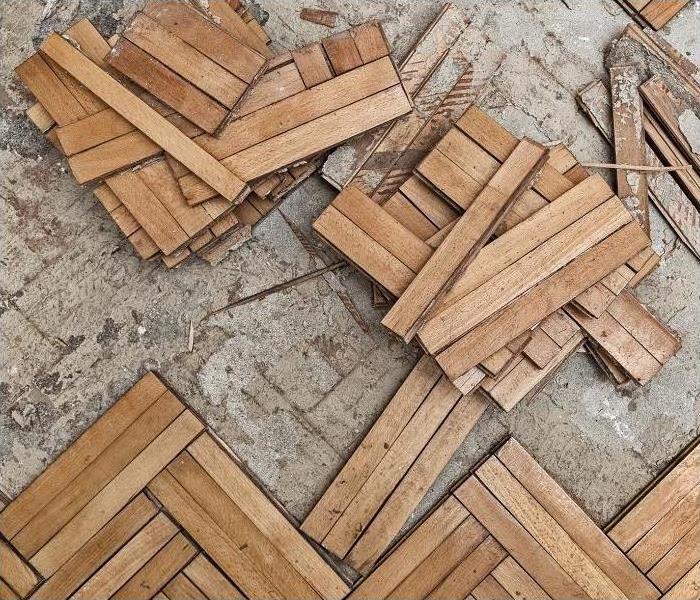How Do I Remove Water from Different Flooring Types?
6/15/2020 (Permalink)
 Water quickly damages flooring materials. Depending upon the scope of damage, sometimes the floor can be salvaged.
Water quickly damages flooring materials. Depending upon the scope of damage, sometimes the floor can be salvaged.
SERVPRO has the Knowledge for Flooring Restoration After Portsmouth Water Loss Events
Your home has many different flooring types, and our SERVPRO professionals have different tools and equipment that can help to restore these after water losses. Many materials compose the construction of your home's flooring, walls, and ceiling systems. Different strategies are necessary to remove water and moisture from these structural elements because so many materials make up your home. Our team of professionals has extensive training and experience to provide the ideal approach for whatever wet surface we encounter.
Recognizing what tools are best for actions like water removal in your homes gets determined during the initial evaluation and damage assessment. Scoping the job is a process where our project manager and crew chief work with the customer to identify preloss conditions and pre-existing conditions so that we can return the property to its original state as efficiently and cost-effectively as possible.
Can You Remove Water from Carpeting?
In areas like your living room and bedrooms, carpeting is one of the typical flooring types encountered in area homes. When migrating water reaches the fibers of carpeted floors, this moisture can get quickly absorbed. It is critical to remove water from carpeting as soon as possible so that moisture does not penetrate the padding and, eventually, the subflooring material. When reconstruction is necessary, the cost of recovery amplifies. Some of the water removal tools and practices for carpeted floors include:
- Carpet Wands – Wands are fierce attachments for wet vacuums and extractors that can pull water from the surface layer and the padding of carpeted floors. These tools are wise choices when the padding is getting replaced.
- Weighted Extractors – Stand on and ride on extraction tools can force the surface layer of carpeting and the padding together against the subflooring. This action forces moisture to the surface for an onboard vacuum to remove.
- Floating Practices – By placing a centrifugal air mover between the top and padding layers of carpeted floors, we can dry both of these materials simultaneously in a floating process. This style is risky as it could cause de-lamination from the primary and secondary backing of the carpet.
Is Wood Flooring Salvageable After Water Damage?
The composition of wood surfaces, especially flooring, makes it a sensitive material to standing surface water. Absorption can happen quickly, which can be disastrous if the water does not get removed quickly. Within as little as 48 hours, saturation can reach the point where it begins to warp and distort wood planks, leaving no option but removal and replacement. Some of the approaches for drying wood floors include:
- Air movers
- Drying Mat System
- Tenting
Does Standing Water Damage Tile?
Many homeowners believe that tile flooring is impenetrable, even to standing water. While it is far more difficult for water to breach even the grout joints between floor tile, a small opening or breach in this water-tight seal can allow penetration to the mortar bed and subflooring material. The water beneath tiling can be destructive and hard to detect initially. Our SERVPRO team can address potential concerns with a simple three-step formula for removing water:
- Extraction – We cannot determine the damage that standing water has done in areas like the kitchen or bathroom until we have removed it. There are multiple extractors, but often wet vacuums and electric submersible pumps are the common implements.
- Surface Moisture Meter – With pooling water addressed, our technicians can work to determine the damage to tile flooring and other exposed materials. Finding moisture pockets often falls to a surface moisture meter device or probing tool to identify if damp areas exist beneath the top layer.
- Drying Mats – If pockets of moisture get detected with thermal imagery and surface meters, we can lay drying mats to slowly draw moisture from the mortar bed and subflooring materials to preserve and protect these areas.
Does SERVPRO Replace Flooring?
We can offer effective solutions for extraction and drying after a full-service restoration and recovery team after a water loss incident. While we strive to restore before replacing, this is not always possible. We have a full team of licensed residential contractors that can repair and reinstall flooring materials that required discarding from water damages. In this way, we can seamlessly transition between mitigation and repairs to get you back to normal life as soon as possible.
While you might not be able to avoid water loss incidents, you can choose the team that oversees your property's restoration and recovery. No matter what materials become affected by water exposure, our SERVPRO of Benton County and Linn County team can help. Contact us today at (541) 745-2097.






 24/7 Emergency Service
24/7 Emergency Service